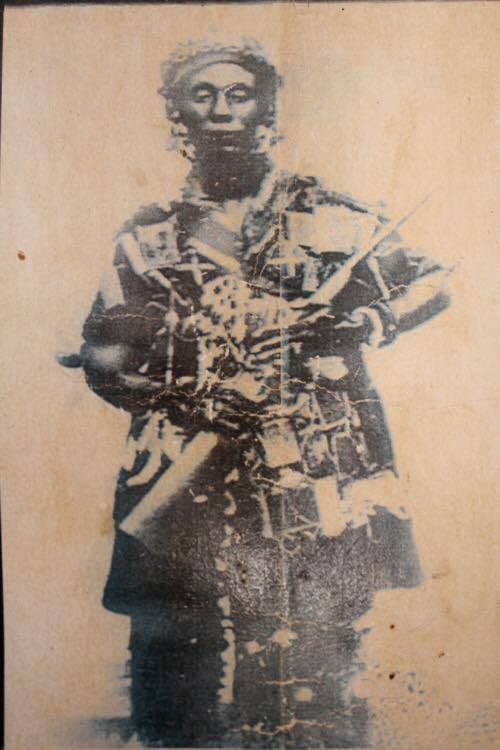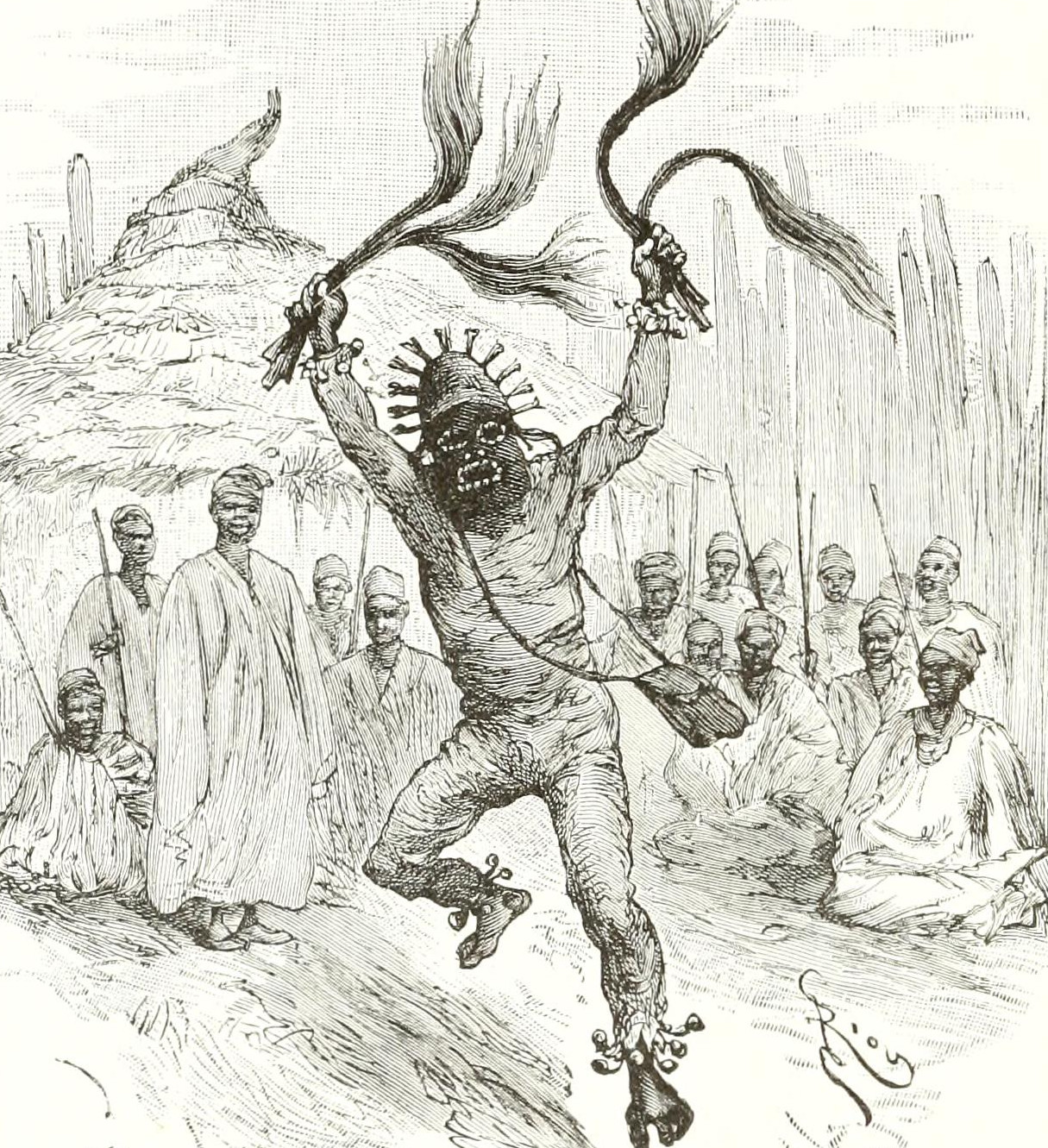Chapter 11
In this chapter, we shall briefly inspect the changes in society and trade in Bornu after the Sokotan conquest.
Below is a map of the erstwhile Bornu provinces of Kuka, Dikoa, Nguru and Kufe(Kufe shall be explained in a later chapter) after the Sokotan conquests.
Bornu fell to the Jihadists in April 1836. It was united with the Sokotan state of Kano except for Kufe which became a part of Hausaland proper.
Al-Kanemi and all Sultans before him sat on a throne inside a curtained cage called fanadir, dagil, or tatatuna. It was like a large cage for a wild animal, with vertical wooden bars to signify their commitment to administration. The Sokotans ceremonially burned this throne after the conquest to signify the end of one era and the dawn of another.
Al-Kanemi inside the Digil throne meeting with British explorers Hugh Clapperton and Dixon Denham in 1823
With the Sokotan conquest, the dominance and high status of the Kanuri people came to an end. Originally a pastoral people, the Kanuri were one of many Nilo-Saharan groups indigenous to the Central South Sahara, beginning their expansion in the area of Lake Chad in the late 7th century, and absorbing both indigenous Nilo-Saharan and Chadic (Afro-Asiatic) speakers. Since the 11th century, the Kanuri had completely dominated the empire. These people held all the high positions and it was Kanuri Sultans who would rule Bornu till 1836.
Eventually, by the middle of the second millennium, the Kanuri had all but displaced all other groups while others had been assimilated. It was also at this point that the Kanuri nobility accepted Islam and like most of West Africa, a new era of Mixed Islam started.
After Sultan Abu Bakr's conquest, the Kanuri language was banned from all official uses. An attempt was made to replace it with Fulani and Arabic languages. Additionally, the Kanuri nobility was cut down. All titles that the Kanuris had taken upon themselves like 'Haji' or 'Shehu' were removed. The assimilation was in fact made easier by the protests and rebellions that followed. Most of the resistance to the assimilation was cut down in battle. Their lands were bequeathed to loyal Fulani and Hausa warriors who had made the victory possible.
The Azzan would also henceforth be announced only in Arabic and not in Kanuri as the Mixed Islamic regime had done.
Islam replaced mixed Islam as the dominant religion in Bornu after the conquest. During and immediately after the war of 1836, the Sokotans had butchered so many pagans that entire villages were depopulated. Many more were enslaved. By 1838, the Sokotans had already forced more than 90% of the citizens of Dikoa and Kuka to accept. However it was very difficult to fully convert the countryside to Islam and serious efforts were discontinued after 1838. What happened however was that many pagans became Muslims in name for protection, to acquire a respected standing in society and mainly to avoid the Jizya tax which was a tax levied on all Non-Muslim adult males to compensate for the fact that they were a burden on the Muslim government. This was because, unlike Muslims, these pagans did not have to pay their yearly dues to the Haj Pilgrims and did not have to swear on the Quran and give donations to the poor. Additionally, many nomadic peoples outside the borders of civilization also began to accept Islam while retaining their earlier faiths.
This is an important conclusion not only of the Bornu conquests but of the Fulani and Massina Jihads in general. While they achieved the destruction of mixed Islam locally, they increased the scope of mixed Islam outside the borders of their realms. It went like a wave.
Now we will learn about trade and the condition of the towns and cities.
The capital of Bornu was the town of Kuka.
The town had been built by Al-Kanemi himself in 1814 on the site of a big merchant camp. Kuka sat on a major Trans-Saharan trade route linking Tripoli to Hausaland. It was also an important route for slave traders and in fact that was the main trade of the route.
However, shortly after the Sokotan conquest, the town's importance and prosperity went into a slow but stead decline. There were multiple reasons for this.
With the conquest of Tripoli by the Ottomans, the slave trade in Tripoli was atleast officially abolished. Meanwhile to the south, the Sokotan conquest of Bornu and Damagaram was followed by an intensification of taxes and tributes. Sultan Abu Bakr's constant wars needed financing and hence the Sokotans collected much more taxes and collected them much more efficiently than the rulers of before. This resulted in a situation where the Berber traders who mostly dominated the routes simply began to find it unprofitable and risky to continue the trade. This did not happen in one day of course but by 1840, the trade through that route had already declined significantly.
The second reason for the decline for Kuka was that after 1836 it ceased to be a capital city of an empire and this brought an obvious diminishment to the prestige and importance of the town. Muslim Scholars, warriors and other intellectuals flocked to Sokoto instead and the pagan scholars were either killed or ceased to play an important role in society.
The third reason was the killing of a sizeable portion of the population in the war itself.
The Sokotan rule did however bring some good too. The Sokotans built the first ever fishing port on Lake Chad in history. This and the decline of other trades made fishing one of the main livelihoods of many. Additionally, the Sokotans built a number of new mosques and Madrasas in the lands of the Bornu empire which would in time create a new generation of Islamic scholars.
If Kuka had seen a decline, then the town of Dikoa was completely removed from the map.
Dikoa was originally built as a fort around the same time as the town of Kuka was built. By the 1820s and 1830s, a small town had slowly sprung up around it to serve the interests of the soldiers inside the fort. From gambling dens to harems to cheap markets to blacksmiths. The danger from Sokoto increased the importance of the fort and as a result, the town grew. However, the conquest of 1836 destroyed much of the town around the fort.
After the conquest, the fort was rebuilt but the town wasn't. Furthermore, with the danger to the fort no longer present, the town did not rebuild and most of the population went back to the countryside and to more basic lifestyles. This had the side effect of actually increasing the revenue from farming and the tributes from cattle-herders. The fort was strengthened and a mosque was built inside it but that was all. Dikoa thus turned into a strong fort surrounded by a rich countryside.
The last and tiniest settlement in today's chapter is Nguru. There is a variety of landscape types in the area, including the protected Hadejia-Nguru wetlands of Nguru lake and the "Sand Dunes", a semi-desert area.
Very little is known about Nguru from this period. There did exist a town here which had evolved from small settlements around the major crossing points on the Nguru river and the wetlands. The population in the town itself is estimated to be no greater than 750 until around 1860. Most of the local commerce involved adaption of travelers to the wetlands. Boatmen, herb makers(Since malaria was a deadly danger around the stagnant waters of the wetlands) and lastly a number of provision sellers.
Nothing much changed in the whole town after the Sokotan conquest except for the building of a small mosque which would crumble soon after due to the unstable soil in the area. No further attempt was made to repair the mosque. Only one line in the memoirs of Muhammadu Attahiru give a clue to any changes in Nguru at all. In one of the paragraphs explaining the culling of pagan fortune token sellers in Kuka, he also states that,
"......and the queer priests of Nguru were ordered not to sell anymore tokens to wetland travellers or they would be cut down too"
The Sokotan conquest thus did change many of the demographic, religious and mainly financial aspects of civilization in Bornu for good or bad.
We shall resume the history from the next chapter.




















